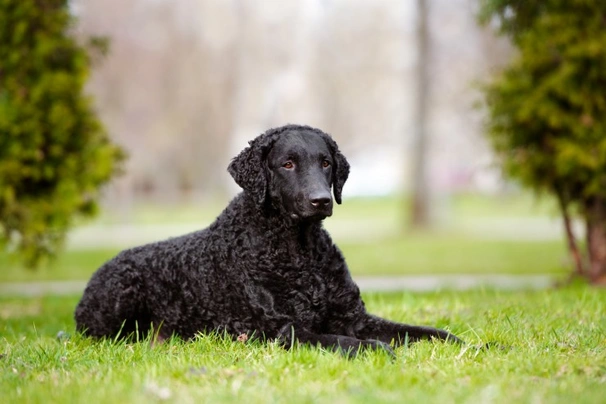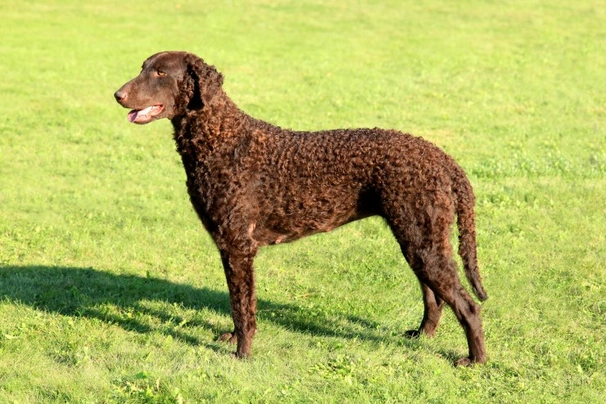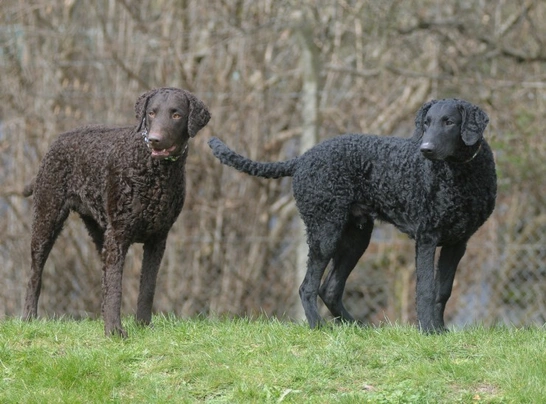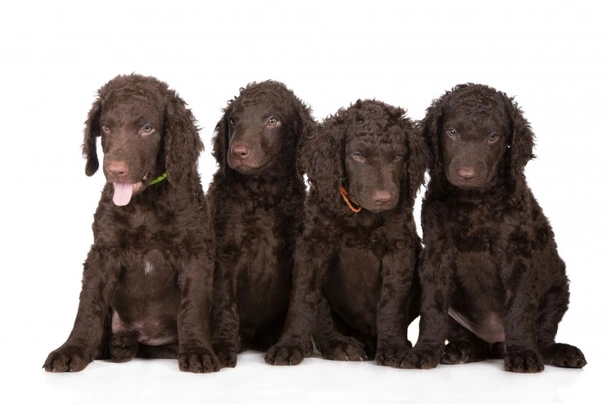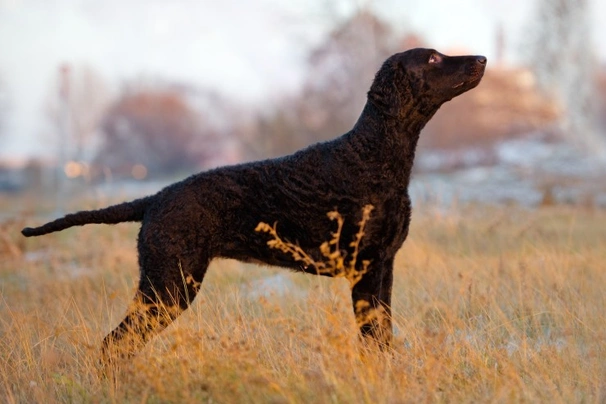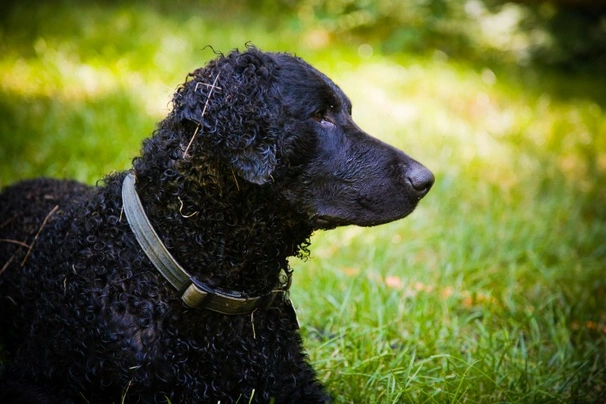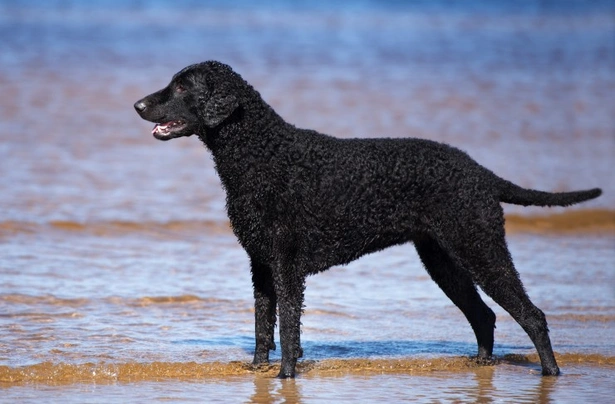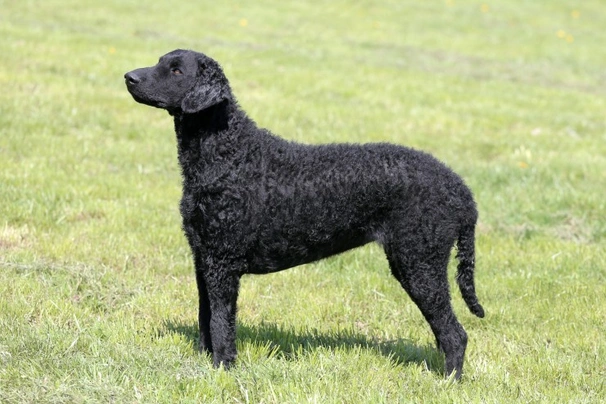Curly Coated Retriever
Pros
Cons
Introduction of the Curly Coated Retriever
The Curly Coated Retriever has a unique coat that consists of a mass of small crisp tight curls which allows these dogs to shake off water in a matter of seconds when wet leaving them virtually dry. The breed is thought to be one of the oldest “retrievers” around. They have always been renowned for their skills in the field and highly prized for their retrieving abilities. They have also become a popular choice both as companion dogs and family pets thanks to their striking coats and their very kind natures especially when they are around children. With this said Curly Coated Retrievers are not the best choice for first-time dog owners because they need to be handled with a firm but gentle hand to help dogs understand who is boss.
Being very intelligent they are easy to train and do well in agility although not always as reliable as many other breeds. The Curly Coated Retriever is a late developer only really maturing when they are three years old which means they can be a bit wilful up until then which has to be taken into account during their training. However if well socialised and trained from a young age these lovely dogs are a joy to have around both in a home environment and in the field.
History of the Curly Coated Retriever
The actual ancestry of the Curly Coated Retriever remains unknown but there are records of very similar looking dogs dating back to 1803. Enthusiasts believe that they could be one of the first retrieving breeds used as “retrievers” in England. The breed was first shown in the UK as early as 1860 with a breed club having been established in 1896. A standard was then drawn up in 1913 and during the mid-1900’s Curlies were among one of the most popular companions and family pets than they were in the field.
It is thought that various breeds were used to develop the Curly Coated Retriever namely the Large Rough Water Dog the Lesser Newfoundland the Tweed Water Spaniel as well as the Irish Water Spaniel Barbet Poodle and the Wetterhound. The breed remained popular right up to the First World War but both wars saw breed numbers fall dramatically. This together with the introduction of the Labrador had a serious impact on the Curly Coated Retriever’s popularity.
Fortunately thanks to the efforts of breed enthusiasts the breed was saved from vanishing altogether with breeders establishing breeding programmes during the 1930’s. Many dogs were exported abroad to save them but with the advent of the Second World War their numbers dropped dramatically once again. At the end of the war breeding programmes were again set up to save the breed and their numbers rose again with Curlies being exported to countries like Scandinavia the US and Australia during the 1950’s and 60’s.
The Curly Coated Retriever Club was founded by Frank Till in 1951 with the first “Open Show” having been organised in September 1973 with 136 dogs being entered. The Kennel Club agreed for the club to organise a Championship Show in 1984 with 70 Curlies being entered. Breed numbers continued to rise right up to the 1970’s and 80’s thanks to their willingness to work and their kind loyal natures in a home environment.
The Curly Coated Retriever has always proved to be a very versatile dog and today they are very sought after with well-bred puppies commanding a lot of money. However as previously mentioned few puppies are bred and registered with the Kennel Club every year and as such anyone wanting to share a home with a Curly would need to register their interest with breeders for the pleasure of doing so.
Interesting facts about the breed
- Is the Curly Coated Retriever a vulnerable breed? Yes they have been placed on the Kennel Club’s list of native vulnerable breeds with not many puppies being registered every year
- Many people think that Curlies could be a Poodle cross which could well be true
- Curlies do moult with males typically shedding their coats once a year whereas their female counterparts shed twice a year
- The Curly only has two colour coats namely dark brown or black with a dark brown coloured coat being referred to as “liver”
- The breed is believed to be on of the oldest UK “retrievers”
Appearance of the Curly Coated Retriever
Height at the withers: Males 64 - 69 cm Females 58 - 64 cm
Average weight: Males 32 - 41 kg Females 23 - 32 kg
Curly Coated Retrievers have very distinct looking coats that offer them a tremendous amount of protection from the elements. They also have quite wedge-shaped heads when seen in profile and there's a slight stop with dogs boasting nice muzzles. Their nose can either be black or brown depending on a dog's coat colour. Their eyes are large and oval in shape being set obliquely on a dog's face. They can either be black or brown to match a dog's coat.
A Curly Coat's ears are on the small side and they are set just above the level of a dog's eyes but always lie close to their head and they are well covered in tiny curls. These dogs have a strong jaw with a perfect scissor bite where their upper teeth neatly overlap their lower ones. Their necks are slightly arched and strong being moderately long flowing neatly down to a dog's well laid-back shoulders.
Forequarters are muscular and well developed with dogs boasting straight front legs that are well set under their body. Chests are deep with well sprung ribs and they reach well back with dogs also having a well-developed brisket and their fore chest is clearly visible. Loins are powerful and deep with dogs having slightly tucked up flanks. Toplines are level strong and hindquarters are muscular and powerful with dogs having strong back legs. Feet are round and tight with dogs having well-arched toes. Their tail flows from their topline which dogs carry straight and level to their toplines when alert or on the move.
When it comes to their coat Curly Coated Retrievers boast having one that is covered in a thick mass of tight and crisp curls that lie close to their bodies right from their occiputs to the tips of their tails with no undercoat. Accepted breed colours for Kennel Club registration are as follows:
- Black
- Liver
It is worth noting that the accepted breed colours for Kennel Club registration can differ from those set out in the breed standard which are as follows:
- Black
- Liver
Gait/movement
When a Curly Coated Retriever moves they do so with effortless ease showing lots of drive from behind and plenty of reach in front. When dogs pick up speed their legs typically converge.
Faults
The Kennel Club frowns on any exaggerations or departures from the breed standard and would judge the faults on how much they affect a dog's overall health and wellbeing as well as their ability to perform.
Males should have both testicles fully descended into their scrotums and it is worth noting that a dog can be a little lighter or heavier as well as slightly taller or shorter than set out in the Kennel Club breed standard which is only given as a guideline.
Temperament of the Curly Coated Retriever
Temperament wise the Curly Coated Retriever is known to be a very easy going and loyal character always ready and willing to please. They are easy to train because they are so intelligent which means in the right hands and with the correct amount of guidance these dogs are a real pleasure to have around. However they need to be well trained and socialised from a young age so they grow up to be well-balanced obedient mature dogs.
They are not the ideal choice for first-time dog owners because Curly Coated Retrievers need to know their place in the pack and they are never happier than when they know they can look to their owners for guidance and direction. The other thing to bear in mind is the breed matures much later than many other breeds which is when they are about 3 years old. In short they do tend to be quite wilful for much longer than other breeds which is why their training has to be consistent from the word go and into their rather long adolescence. They can be a little stand offish when they meet someone for the first time but these dogs would rarely show any sort of aggressive behaviour towards strangers preferring to just keep their distance which should not be confused with shyness.
Are they a good choice for first time owners?
Curly Coated Retrievers are not the best choice for first time dog owners because they need to know who is boss and their place in the pack. They can be strong-willed and therefore could well get the better of a novice owner.
What about prey drive?
Although Curlies are social albeit standoffish with strangers by nature they have working and hunting dogs in their lineage and therefore have a high prey drive. As such care should always be taken as to where and when a dog can run off the lead more especially if there is livestock or wildlife close by.
What about playfulness?
The Curly is an energetic fun-loving dog that has a great sense of humour with a great sense of fun. They enjoy playing all sorts of interactive games and they do well at many canine sports which includes agility and obedience.
What about adaptability?
The Curly Coated Retriever is better suited to households with large well-fenced secure back gardens that a dog can roam in whenever possible to let off steam. As such they are not the best choice for anyone who lives in an apartment in town.
What about separation anxiety?
Although Curlies form strong ties with their families they are not generally known to suffer from separation anxiety. With this said no dog likes to be left for long periods of time which often results in them developing destructive and unwanted behavioural issues as a way of relieving their stress.
What about excessive barking?
Some Curlies like the sound of their own voices a little too much which is something that needs to be gently nipped in the bud when a dog is still young being careful not to frighten them. Others will only bark when there are strangers about or when something they don't like is going on in their surroundings.
Do Curly Coated Retrievers like water?
Curlies love being in and around water and will take to it whenever they can. However if anyone who owns a dog that does not like water should never force them to go in because it would just end up scaring them. With this said care should always be taken when walking a Curly off the lead anywhere near more dangerous watercourses just in case a dog decides to leap in and then needs rescuing because they cannot get out of the water on their own. It is also important to thoroughly dry a dog’s ears once they’ve been swimming to prevent any sort of ear infection from flaring up.
Are Curly Coated Retrievers good watchdogs?
Because Curlies are wary of strangers they do make good watchdogs and would be quick off the mark to let an owner known when something they don’t like is going on in their surroundings although they would rarely do this aggressively preferring to stand their ground and bark.
Intelligence / Trainability of the Curly Coated Retriever
During their training Curly Coated Retrievers need to be handled with a firm but gentle and fair hand. Their training must be consistent right from the word go. If they are taught the right way these lovely dogs are affectionate characters known to be extremely good around children. The key to a happy well balanced Curly Coated Retriever is to give them lots of physical and mental exercise. Their training should be kept varied because if things get too repetitive a Curly would soon get bored and lose interest in a training session which makes keeping them focused that much harder.
Like all puppies Curly Coated Retrievers are incredibly cute when young and it is all too easy to spoil them when they first arrive in new homes. As soon as a puppy is nicely settled owners must start out as they mean to go on by laying down ground rules and boundaries so that a Vallhund puppy understands what is expected of them. It helps establish a pecking order and who the alpha dog is in the household. The first commands a puppy should be taught are as follows:
- Come
- Sit
- Stay
- Heel
- Quiet
- Leave it
- Down
- Bed
Children and other
When Curly Coated Retrievers are taught the right way from the word go they are affectionate characters known to be very good around children. However care has to be taken because these large dogs can play a bit "rough" with the kids which means any interaction between them should be supervised by an adult to ensure things don't get too boisterous which may well end up with someone getting hurt.
If well socialised from a young age and introduced to as many other animals and dogs after they have been fully vaccinated the Curly is known to get on well with them. If they have grown up with a cat in the house they are generally fine around them too. However a curly would think nothing of chasing the neighbour's cat because they would see them as "fair game".
Health of the Curly Coated Retriever
The average life expectancy of a Curly Coated Retriever is between 8 and 13 years when properly cared for and fed an appropriate good quality diet to suit their ages.
Like so many other breeds the Curly Coated Retriever is known to suffer from a few hereditary health issues which are worth knowing about if you are planning share your home with one of these active and good-looking dogs. The conditions that seem to affect the breed the most include the following:
- Hip dysplasia – dogs should be hip scored through the BVA/KC hip dysplasia scheme
- Elbow dysplasia – dogs should be elbow tested through the BVA/KC elbow scheme
- Progressive retinal atrophy (PRA) – annual testing
- Exercise Induced Collapse (EIC) – DNA test available
- Glycogenosis (GSD) type IIIa – DNA test available
- Cataracts
- Cancer
- Bloat/Gastric Torsion
- Epilepsy & Seizures – it is worth noting that not all seizures turn out to be epilepsy
- Renal failure
- Entropion
- Distichiasis
- Allergies
- Alopecia (seasonal hair loss from flanks)
- Canine follicular dysplasia - hair loss
Because the breed is prone to these health issues it's important for them to have regular health checks with the vet and especially as they get older so that if any health issues can be caught early and treated.
It is worth noting that the breed’s average COI with The UK Kennel Club is 13.5%.
What about vaccinations?
Curly puppies would have been given their initial vaccinations before being sold but it is up to their new owners to make sure they have their follow-up shots in a timely manner with the vaccination schedule for puppies being as follows:
- 10 -12 weeks old bearing in mind that a puppy would not have full protection straight away but would be fully protected 2 weeks after they have had their second vaccination
There has been a lot of discussion about the need for dogs to have boosters. As such it's best to talk to a vet before making a final decision on whether a dog should continue to have annual vaccinations which are known as boosters.
What about spaying and neutering?
A lot of vets these days recommend waiting until dogs are slightly older before spaying and neutering them which means they are more mature before undergoing the procedures. As such they advise neutering males and spaying females when they are between the ages of 6 to 9 months old and sometimes even when a dog is 12 months old.
Other vets recommend spaying and neutering dogs when they are 6 months old but never any earlier unless for medical reasons. With this said many breeds are different and it is always advisable to discuss things with a vet and then follow their advice on when a dog should be spayed or neutered.
What about obesity problems?
As with other breeds some Curlies gain weight after they have been spayed or neutered and it's important to keep an eye on a dog's waistline just in case they do. If a dog starts to put on weight it's important to adjust their daily calorie intake and to up the amount of exercise they are given. Older dogs too are more prone to gaining weight and again it's essential they be fed and exercised accordingly because obesity can shorten a dog's life by several years. The reason being that it puts a lot of extra strain on a dog's internal organs including the heart which could prove fatal.
What about allergies?
Curlies are prone to suffering from all sorts of allergies and it's important for a dog to see a vet sooner rather than later if one flares up. Allergies can be notoriously hard to clear up and finding the triggers can be challenging. With this said a vet would be able to make a dog with an allergy more comfortable while they try to find out the triggers which could include the following:
- Certain dog foods that contain high levels of grains and other cereal-type fillers
- Airborne pollens
- Dust mites
- Environment
- Flea and tick bites
- Chemicals found in everyday household cleaning products
Participating in health schemes
All responsible Curly Coated Retriever breeders would ensure that their stud dogs are tested for known hereditary and congenital health issues known to affect the breed by using the following schemes:
- Hip scoring through the BVA/KC hip dysplasia scheme
- Elbow dysplasia – dogs should be elbow tested through the BVA/KC elbow scheme
- Progressive retinal atrophy (PRA) – annual testing
- Exercise Induced Collapse (EIC) – DNA test available
- Glycogenosis (GSD) type 111a – DNA test available
What about breed specific breeding restrictions?
Apart from the standard breeding restrictions that are in place for all Kennel Club registered breeds there are no other breed specific breeding restrictions in place for the Curly Coated Retriever.
What about Assured Breeder Requirements?
It is mandatory for all Kennel Club Assured Breeders to use the following test on stud dogs and all other breeders are strongly advised to follow suit:
Caring for the Curly Coated Retriever
As with any other breed Curly Coated Retrievers need to be groomed on a regular basis to make sure their coats and skin are kept in top condition. They also need to be given regular daily exercise to ensure they remain fit and healthy. On top of this dogs need to be fed good quality food that meets all their nutritional needs throughout their lives.
Caring for a Curly Coated Retriever puppy
Curly puppies are boisterous and full of life which means it's essential for homes and gardens to be puppy-proofed well in advance of their arrival. A responsible breeder would have well socialised their puppies which always leads to more outgoing confident and friendly dogs right from the word go. With this said any puppy is going to feel vulnerable when they leave their mother and littermates which must be taken into account. The longer a puppy can remain with their mother the better although it should never be for too long either.
It's best to pick a puppy up when people are going to be around for the first week or so which is the time needed for a puppy to settle in. Puppy-proofing the home and garden means putting away any tools and other implements that a boisterous puppy might injure themselves on. Electric wires and cables must be put out of their reach because puppies love chewing on things. Toxic plants should be removed from flowerbeds and the home too.
Puppies need to sleep a lot to grow and develop as they should which means setting up a quiet area that's not too out of the way means they can retreat to it when they want to nap and it's important not to disturb them when they are sleeping. It's also a good idea to keep "playtime" nice and calm inside the house and to have a more active "playtime" outside in the garden which means puppies quickly learn to be less boisterous when they are inside.
The documentation a breeder provides for a puppy must have all the details of their worming date and the product used as well as the information relating to their microchip. It is essential for puppies to be wormed again keeping to a schedule which is as follows:
- Puppies should be wormed at 6 months old
- They need to be wormed again when they are 8 months old
- Puppies should be wormed when they are 10 months old
- They need to be wormed when they are 12 months old
Things you'll need for your puppy
There are certain items that new owners need to already have in the home prior to bringing a new puppy home. It's often a good idea to restrict how much space a puppy plays in more especially when you can't keep an eye on what they get up to bearing in mind that puppies are often quite boisterous which means investing in puppy gates or a large enough playpen that allows a puppy the room to express themselves while keeping them safe too. The items needed are therefore as follows:
- Good quality puppy or baby gates to fit on doors
- A good well-made playpen that's large enough for a puppy to play in so they can really express themselves as puppies like to do
- Lots of well-made toys which must include good quality chews suitable for puppies to gnaw on bearing in mind that a puppy will start teething anything from when they are 3 to 8 months old
- Good quality feed and water bowls which ideally should be ceramic rather than plastic or metal
- A grooming glove
- A slicker brush or soft bristle brush
- Dog specific toothpaste and a toothbrush
- Scissors with rounded ends
- Nail clippers
- Puppy shampoo and conditioner which must be specifically formulated for use on dogs
- A well-made dog collar or harness
- A couple of strong dog leads
- A well-made dog bed that's not too small or too big
- A well-made dog crate for use in the car and in the home that's large enough for a puppy to move around in
- Baby blankets to put in your puppy's crate and in their beds for when they want to nap or go to sleep at night
Keeping the noise down
All puppies are sensitive to noise including Curly Coated Retriever puppies. It's important to keep the noise levels down when a new puppy arrives in the home. TVs and music should not be played too loud which could end up stressing a small puppy out which could result in them being withdrawn timid and shy.
Keeping vet appointments
As previously mentioned Curly puppies would have been given their first vaccinations by the breeders but they must have their follow up shots which is up to their new owners to organise. The vaccination schedule for puppies is as follows:
- 10 -12 weeks old bearing in mind that a puppy would not have full protection straight away but would only be fully protected 2 weeks after they have had their second vaccination
When it comes to boosters it's best to discuss these with a vet because there is a lot of debate about whether a dog really needs them after a certain time. However if a dog ever needed to go into kennels their vaccinations would need to be fully up to date.
What about older Curly Coated Retrievers when they reach their senior years?
Older Curlies need lots of special care because as they reach their golden years they are more at risk of developing certain health concerns. Physically a dog's muzzle may start to go grey but there will be other noticeable changes too which includes the following:
- Coats become coarser
- A loss of muscle tone
- They can either become overweight or underweight
- They have reduced strength and stamina
- Older dogs have difficulty regulating their body temperature
- They often develop arthritis
- Immune systems do not work as efficiently as they once did which means dogs are more susceptible to infections
- Older dogs change mentally too which means their response time tends to be slower as such they develop the following:
- They respond less to external stimuli due to impaired vision or hearing
- They tend to be a little pickier about their food
- They have a lower pain threshold
- Become intolerant of any change
- Often an older dog can feel disorientated
Living with a Curly Coated Retriever in their golden years means taking on a few more responsibilities but these are easily managed and should include looking at their diet the amount of exercise they are given how often their dog beds need changing and keeping an eye on the condition of their teeth.
Older Curlies need to be fed a good quality diet that meets their needs at this stage of their lives all the while keeping a close eye on a dog's weight. A rough feeding guide for older dogs is as follows bearing in mind they should be fed highly digestible food that does not contain any additives:
- Protein content should be anything from 14 – 21%
- Fat content should be less than 10%
- Fibre content should be less than 4%
- Calcium content should be 0.5 – 0.8%
- Phosphorous content should be 0.4 – 0.7%
- Sodium content should be 0.2 – 0.4%
Older Curlies don't need the same amount of daily exercise as a younger dog but they still need the right amount of physical activity to maintain muscle tone and to prevent a dog from putting on too much weight. All dogs need access to fresh clean water and this is especially true of older dogs when they reach their golden years because they are more at risk of developing kidney disorders.
Grooming of the Curly Coated Retriever
Although their coat is a mass of curls these dogs are low maintenance on the grooming front. A weekly brush with a soft slicker brush is all it takes to prevent tangles from forming and because their coats are so weather-resistant water and mud just rolls off it. If their coat grows too long just an occasional trim would keep things tidy which can be done by a professional groomer when necessary.
It's also important to check a dog's ears on a regular basis and to clean them when necessary. If too much wax builds up in a dog's ears it can lead to a painful infection which can be hard to clear up. In short prevention is often easier than cure when it comes to ear infections.
Exercise of the Curly Coated Retriever
When it comes to exercise Curly Coated Retrievers love to be in water and are the perfect choice for people who lead active outdoor lives with a canine companion at their side. These dogs need a minimum of 2 hour’s daily exercise and it must include as much mental stimulation as possible. A shorter walk in the morning would be okay but a much longer and more interesting one in the afternoon is a must to keep these dogs happy and healthy. They also benefit from being allowed to roam around a back garden as often as they can but the fencing must be very secure to keep these dogs in.
The Curly Coat excels at many canine sports which includes activities like obedience flyball and agility thoroughly enjoying the interaction they get with their owners. As previously mentioned they also love being in water which means care has to be taken when walking a Curly off the lead anywhere near more dangerous water courses because they might just decide to jump in.
With this said young Curly puppies should not be given too much exercise because their joints and bones are still growing and too much pressure on them could result in causing a dog a few problems later on in their lives. They should not be allowed to jump up or off furniture nor should they be allowed to run up and down the stairs because this puts too much pressure on their still growing joints and limbs.
Feeding of the Curly Coated Retriever
If you get a Curly puppy from a breeder they would give you a feeding schedule and it's important to stick to the same routine feeding the same puppy food to avoid any tummy upsets. You can change a puppy's diet but this needs to be done very gradually always making sure they don't develop any digestive upsets and if they do it's best to put them back on their original diet and to discuss things with the vet before attempting to change it again.
Older dogs are not known to be fussy or finicky eaters but this does not mean you can feed them a lower quality diet. It's best to feed a mature dog twice a day once in the morning and then again in the evening making sure it's good quality food that meets all their nutritional requirements. It's also important that dogs be given the right amount of exercise so they burn off any excess calories or they might gain too much weight which can lead to all sorts of health issues. Obesity can shorten a dog's life by several years so it's important to keep an eye on their waistline from the word go.
Because Curly Coated Retrievers are prone to suffer from bloat it is important that they be fed twice a day instead of giving them just one larger meal a day. It's also a good idea to invest in a stand to place their feed bowl which makes it easier for these large dogs to eat comfortably without having to stretch their necks down low to reach their food. You should never feed them just before or just after they have eaten either because this puts them more a risk of suffering from bloat.
Feeding guide for a Curly Coated Retriever puppy
Puppies need to be fed a highly nutritious good quality diet for them to develop and grow as they should. As a rough guide a Curly puppy can be fed the following amounts every day making sure their meals are evenly spread out throughout the day and it's best to feed them 3 or 4 times a day:
- 2 months old - 286g to 290g depending on puppy's build
- 3 months old - 365g to 392g depending on puppy's build
- 4 months old - 400g to 425g depending on puppy's build
- 5 months old - 454g to 495g depending on puppy's build
- 6 months old - 505g to 557g depending on puppy's build
- 7 months old - 506g to 559g depending on puppy's build
- 8 months old - 471g to 524g depending on puppy's build
- 9 months old - 440g to 491g depending on puppy's build
- 10 months old - 402g to 458g depending on puppy's build
- 11 months old - 365g to 429g depending on puppy's build
- 12 months old - 363g to 402g depending on puppy's build
- 13 months old - 360g to 399g depending on puppy's build
- 14 months old - 357g to 395g depending on puppy's build
Once a puppy is 15 months old they can be fed adult dog food.
Feeding guide for an adult Curly Coated Retriever
Once fully mature an adult Curly Coated Retriever should be fed a good quality diet to ensure their continued good health. As a rough guide an adult Curly can be fed the following amounts every day:
- Dogs weighing 23 kg can be fed 332g to 443g depending on activity
- Dogs weighing 32 kg can be fed 352g to 463g depending on activity
- Dogs weighing 41 kg can be fed 381g to 501g depending on activity
Curly Coated Retriever price
If you are looking to buy a Curly Coated Retriever you may have to go on a waiting list because not many puppies are registered with The Kennel Club every year and you would need to pay anything from £600 to over £800 for a well-bred pedigree puppy. The cost of insuring a male 3-year-old Curly in northern England would be £23.76 a month for basic cover but for a lifetime policy this would set you back £49.67 a month (quote as of April 2018). When insurance companies calculate a pet's premium they factor in several things which includes where you live in the UK and a dog's age and whether they have been neutered or spayed among other things
When it comes to food costs you need to buy the best quality food whether wet or dry to feed your dog throughout their lives making sure it suits the different stages of their lives. This would set you back between £50 - £60 a month. On top of this you would need to factor in veterinary costs if you want to share your home with a Curly and this includes their initial vaccinations their annual boosters the cost of neutering or spaying your dog when the time is right and their yearly health checks all of which quickly adds up to over a £1000 a year.
As a rough guide the average cost to keep and care for a Curly Coated Retriever would be between £80 to £110 a month depending on the level of insurance cover you opt to buy for your dog but this does not include the initial cost of buying a well-bred Kennel Club registered pedigree Curly Coated Retriever puppy.
Buying advice
When visiting and buying any puppy or dog there are many important things to consider and questions to ask of the breeder/seller. You can read our generic puppy/dog advice here which includes making sure you see the puppy with its mother and to verify that the dog has been wormed and microchipped.
Finding well-bred Curly Coated Retrievers can be difficult with few puppies being registered with the Kennel Club every year which means well-bred puppies can often command a lot of money. As such with Curly Coated Retrievers there is specific advice questions and protocols to follow when buying a puppy which are as follows:
- Beware of online scams and how to avoid them. You may see online and other adverts by scammers showing images of beautiful Curly Coated Retrieverpuppies for sale at very low prices. However the sellers ask buyers for money up front before agreeing to deliver a puppy to a new home. Potential buyers should never buy a puppy unseen and should never pay a deposit or any other money online to a seller. You should always visit the pet at the sellers home to confirm they are genuine and make a note of their address.
- As previously touched upon Curly Coated Retrievers have been placed on the Kennel Club list of native vulnerable breeds and finding puppies can prove challenging. As such some amateur breeders/people breed from a dam far too often so they can make a quick profit without caring for the welfare of the puppies their dam or the breed in general. Under Kennel Club rules a dam can only produce 4 litters and she must be between a certain age to do so. Anyone wishing to buy a Curly Coated Retriever puppy should think very carefully about who they purchase their puppy from and should always ask to see the relevant paperwork pertaining to a puppy's lineage their vaccinations their microchipping and the documentation relevant to their parent’s health tests
